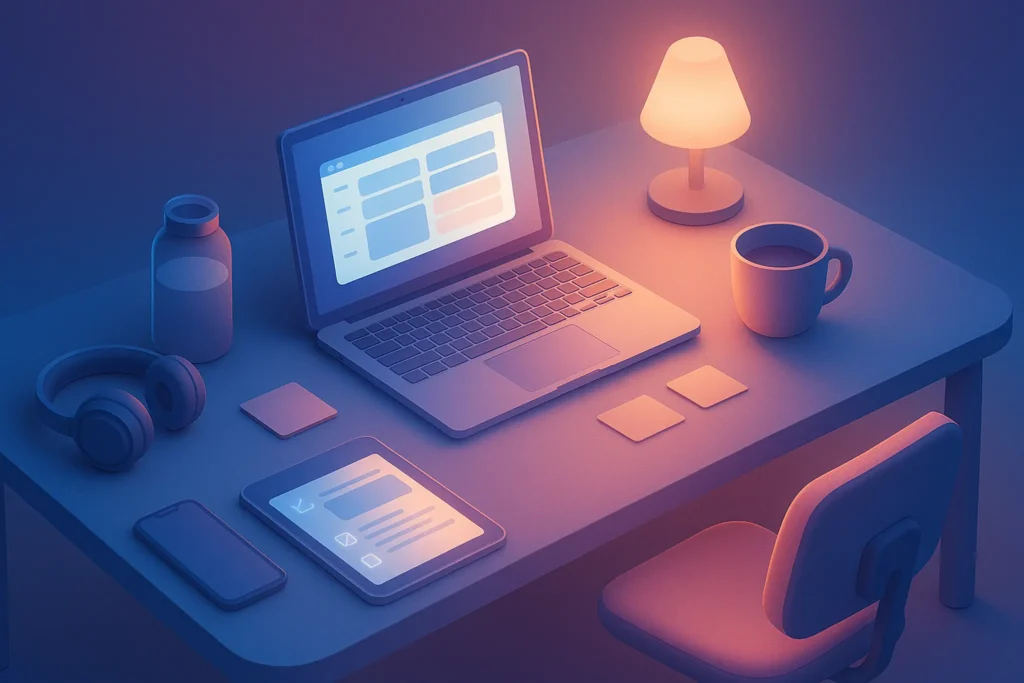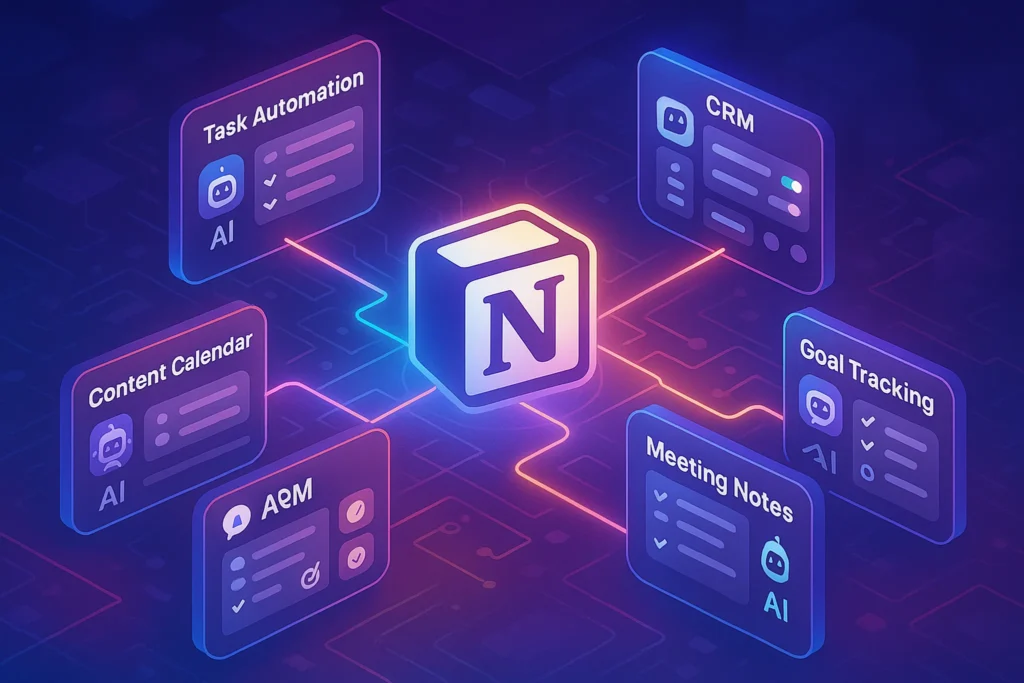-This post may contain affiliate links. If you click on one and make a purchase, I may earn a small commission at no extra cost to you.-
🧭 Introduction
Remote work comes with freedom—and distractions. While 55% of remote employees report higher productivity compared to office settings, that extra output often hides stress from blurred boundaries, physical discomfort, or fragmented routines. This guide breaks down proven strategies—ergonomic setups, daily rituals, digital tool optimization, and focused techniques—to help you maintain clarity and energy all day, even from your kitchen table or home office.
🪑 Design an Ergonomic Workspace That Encourages Focus
Working from home often means working from a couch, dining table, or shared workspace. What starts as a compromise usually evolves into chronic neck tension, focus drift, and fatigue halfway through an afternoon of remote tasks. But the right ergonomic setup does more than just ease your body—it supports your rhythm of work.
Imagine beginning your day in a chair that reminds your muscles of good posture, with feet grounded, back supported, and your eyes aligned with the top third of your screen. Each reorganized item—a monitor lift, a desk light angled just so, paired noise-canceling headphones—removes friction from deep work. You don’t realize how often you lean forward to read tiny text until it disappears.
Having these physical comfort signals helps your brain settle faster into focus. You’re not reminding yourself to sit up straight—you’re simply working. In the long run, this calm posture translates into longer attention spans, fewer micro-breaks to un-crick your neck, and a feeling of professional grounding even in casual spaces.
A comfortable environment isn’t a luxury—it’s a productivity necessity. Poor setup leads to fatigue, discomfort, and frequent breaks that fragment your day. Here’s how to approach your remote workspace with intention:
🛠️ Chair, Desk & Posture
A supportive chair and properly aligned desk are your frontline defense against back pain and energy dips. Sit so your feet rest flat, shoulders relaxed, and eyes aligned with your screen’s top third. Typing with elbows at 90° helps reduce strain and keeps you working smoothly for longer.
💡 Screen, Lighting & Acoustics
Avoid glare by using soft, indirect light, and position screens just beyond arm’s reach. If you’re using a laptop, dock it to an external monitor or laptop stand for better posture. Add a headset or white-noise machine if household sounds interrupt your flow. When subtle distractions are minimized, you plunge deeper into work faster—and stay there.
⏰ Build a Remote-Friendly Daily Routine
Remote days can slip through your fingers unless intentionally anchored—those micro-rituals that signal mental transition. The first sip of coffee alone won’t cut it. Instead, add a short walk around the block, a two-minute journaling prompt, or a piece of music that signals “start time.”
That anchor creates structure without rigidity. By reinforcing it daily, your brain learns: morning walk equals “work awake.” Later, when midday blur hits, stepping outside feels intuitive—not optional. When the workday ends, closing the laptop shouldn’t end in exhaustion; closing it after a moment of reflection—what worked, what shifted, what to prep—ties a neat ribbon around your day.
These rituals bridge the gaps remote life creates. They replicate commute transitions, mark the pace for focus blocks, and help keep mental separation between “on” and “off.” You’ll find yourself working with intention—and stepping away without guilt—because mentally, you’ve already signaled both start and stop.
Working from home gives you flexibility—but without structure, the day can dissolve. Anchored routines bring rhythm to remote life:
🌅 Anchor Your Day with Morning Rituals
Remote workers often miss transition moments like commuting. Recreate them: make coffee, go for a short walk, journal, or read something inspiring. A repeatable routine signals to your brain: “Work mode begins now.”
📅 Core Work Blocks & Breaks
Use time-blocking to carve out deep work periods separated by buffer zones. Sync these with a productivity system—see our Productivity System Guide—to avoid schedule bleed. When blocks shift, you adjust consciously and safeguard focus. Stand, stretch, hydrate, or step outside during breaks—your brain needs reset as much as your body does.
🌙 Evening Shutdown Ritual
Closing your laptop shouldn’t feel abrupt. Wrap up with quick reflections: what went well, what’s pending tomorrow. A consistent wind-down routine stops work from following you into evening time—and helps you recharge.
🧩 Leverage Tools that Support Remote Focus
On-screen notifications act like an addressable siren: their job is to demand your attention, whether you need it or not. Tools like Asana and ClickUp help remote professionals offload cognitive load and breathe easy. When your task list, deadlines, and priorities live in an organized platform, your next step becomes obvious. Decisions become easy, and your attention stays in scope.
Then there’s Slack (or Teams, etc.). With DND settings configured during deep work blocks and visible status set to “Focus Mode,” your teammates know when not to disturb you. Automated email triage tools like SaneBox can hold non-urgent threads until you’re ready. By preventing distractions, these apps reclaim frees you to work in river-deep focus rather than fractured attention.
Taken together, they don’t just manage your tasks and notifications—they structure your mental operating system for remote flow.
The right software can make all the difference between fragmented and focused work:
🛠️ Project Management + Collaboration
Remote teams need structure together, but solo you need ownership. Tools like Asana, Trello, or ClickUp help you break work into tasks with clear status—so no mental bandwidth is wasted wondering what’s next. They also integrate with platforms aimed at teamwork—learn more in our Best AI Tools for Remote Team Collaboration breakdown.
🗣️ Communication Setup
Slack and Teams notifications can erode focus quickly. Create status updates like “In Deep Work“ and use Do Not Disturb during focus blocks. Tools like SaneBox for email delay can defer non-critical threads until you’re ready. That way, you’re responsive—not reactive.
⚙️ Focus & Productivity Tools
Windows Focus Sessions, macOS Focus Mode, and apps like Freedom or Forest can shut out distractions during your best hours. If you need help starting, nested Pomodoro appeal inside time blocks brings structure and calm—check our Time Blocking vs Pomodoro post for workflows.
🧠 Maintain Mental Energy with Real Breaks
When your commute is only 30 steps, your body learns to sit all day. Exercise isn’t just about calories—it’s mental reset. Short walks mid-morning, midday yoga stretches, or stepping outside to water a plant create physical breaks that fuel cognitive clarity. Our brains crave micro-movements—they refresh focus pathways and dissipate stress that builds silently when we sit still.
You can even manage them silently: a tiny stretch between video calls, a cup of tea at 3 PM, or a 15-minute window after lunch. These aren’t interruptions—they’re built-in investments. Pause for a minute, take a breath, reset, and your post-break mindset becomes sharper, more intentional, more present than before.
Being at home tempts us to skip movement—but mental breaks are essential:
-
Take two daily walks—not just kitchen-to-desk loops. Physical movement clears mind clutter while boosting creativity.
-
Use micro-breaks: drink water every hour, stretch, or look away from screens for 15 seconds.
-
Consider midday power naps (10–20 minutes) to sharpen focus and memory. Science shows naps before or after lunch improve the afternoon steep productivity curve.
⚖️ Balance Boundaries & Communication Expectations
Working remote doesn’t mean working unbounded. It means clarity. When your teammates see available hours publicly—via tools like Clockwise—they can schedule meetings without guesswork. Those blocks, labeled “Focus Time” or “Deep Work,” create trust and protect your work rhythm.
Within those blocks, maintaining a boundary—like muting or setting status—signals commitment. When you skip, you invite interruptions. But when your availability is visible and consistent, interruption becomes something your team learns to schedule around. You might still answer a software alert or urgent request—but only on your terms, and without fracturing your focus mid-segment.
When you’re remote, every signal matters—your calendar, availability, and tone:
-
Keep core “available” hours (e.g., 10–12 and 2–4) and communicate them openly.
-
Use calendar tools like Clockwise to share your blocks (see our Productivity System Guide).
-
Build in async workflows: share meeting notes, document decisions, and embed project updates—don’t rely on hallway chats.
These choices reduce friction in collaboration and protect focus hours from last-minute drop-ins.
🧠 Revisit, Reflect, Refine
The difference between a routine and a ritual is learning. Take 10 minutes every week to review your schedule: what plan worked, what energy dips happened, what contexts still derail you? Reflection isn’t judgment—it’s data. With that ride-tested insight, you reshape your calendar blocks, adjust your break sizes, or shift focus weights. This kind of reflection turns work-from-home routines into living systems, not static habits. It helps you sustainably experiment—because mental flow isn’t just found, it’s built.
At the end of each week, don’t just look back—plan forward:
-
Review your calendar to see where focus held or slipped.
-
Ask: “Which routine energized me? When was I off track?”
-
Adjust blocks, rituals, or tools based on real feedback—like how we covered in How to Build a Daily Routine That Actually Sticks.
Reflection is more than improvement; it’s your compass in remote terrain.
🧠 Nerd Verdict
Remote productivity cycles between physical setup, structured time, healthy breaks, smart tools, and routine refinement. Each component contributes to your momentum. Missing one — even if everything else is aligned — can tank output and energy. When aligned, the entire system works as a cohesive day-support engine. Tweak it often—it’s your unique remote work DNA.
❓ FAQ
Q: What if family/kids interrupt focus blocks?
A: Set clear routines with them upfront, have visual cues (like lights or whiteboard), and build small buffer blocks to handle interruptions without derailing flow.
Q: How do I stay focused on fast-changing remote roles?
A: Refresh your blocks daily as tasks shift. Weekly reflection helps you adjust blocks before the week. Use tools like Asana for fast reprioritization.
Q: What if I’m tired of my workspace?
A: Change surface, add a plant or photo, reorient your chair, or try working from a cafe or shared office day once weekly. Small shifts rewire mental focus.
💬 Would You Bite?
What one ritual—like a morning walk, status block, or reflection journal—do you plan to try this week?
Drop a comment and I’ll send you a curated toolkit (Asana setup, Focus Mode tips, and walk + flow journal prompts) to help you get started.👇



